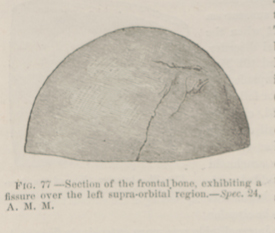Title: H.——, M. L.
Source text: Surgeon General Joseph K.Barnes, United States Army, The Medical and Surgical History of the War of the Rebellion. (1861–65.), Part 1, Volume 2 (Washington, D.C.: Government Printing Office, 1870), 167.
Civil War Washington ID: med.d1e11719
TEI/XML: med.d1e11719.xml
CASE.—Private M. L. H.——, Co. E, 21st Virginia Regiment, aged 20 years, was wounded at Petersburg, Virginia, in the assault on Fort Steadman, March 25th, 1865, by a musket ball which struck the forehead. He was made a prisoner and admitted to the hospital of the Ninth Army Corps at City Point. On March 27th he was conveyed in the hospital transport steamer "State of Maine" to Washington, and placed in the Lincoln Hospital on March 28th, with a wound over the left supra-orbital ridge, apparently indicted by a glancing musket ball. There were no cerebral symptoms when the patient was admitted, and he seemed to be doing well for several days, being quite free from pain or any febrile movement. The pulse was normal and the bowels in good condition. On April 1st, he complained of a dull deep-seated pain over the left eye. Later in the day he was feverish and restless, his countenance was pale, and his pulse slow and weak. On April 2d, he failed rapidly. On the night of the 3d, he was delirious. On the 4th, there was violent raving, which continued until his death, on the afternoon of April 5th, 1865. At the post-mortem examination, a fissure was found extending into the right orbit, and upward beyond the left frontal prominence. The vitreous table beneath was largely depressed. There was a small abscess in the anterior lobe of the left cerebral hemisphere. The specimen was contributed by Acting Assistant Surgeon J. P. Arthur, and is represented in the accompanying wood-cuts, (Fig. 77 and Fig. 78.) Two fragments of the inner table are driven inward to the depth of half an inch, touching each other by their inner edges like the leaves of a folding door just ajar. (See Catalogue Surg. Sect. A. M. M., page 10.)

